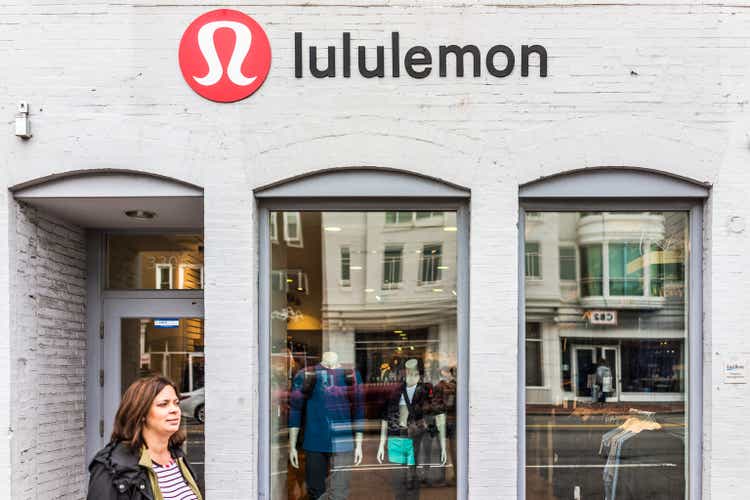
krblokhin/iStock Editorial via Getty Images
A Beat-And-Raise Quarter With Solid Execution
Lululemon (NASDAQ:LULU) is no doubt one of the higher-quality retail names that has recently gotten an unfavorable treatment by the market in a challenging macro backdrop. In 1Q22, the company delivered results that alleviated much of investors’ fear of consumers shifting purchases from products to services and an insurmountable 1Q21 comp. Revenue of $1.6 billion (+32% YoY) was roughly 4% above consensus, while GAAP EPS of $1.48 also beat Street estimates by $0.05. Total comparable sales increased 29%, with store comps up 24% and e-commerce up 33%. GAAP operating margin of 16% and net margin of 12% were roughly in line with 1Q21.
Perhaps what was more surprising to analysts was that Lululemon (1) guided to the upside for 2Q22 (revenue of $1.76 billion at midpoint, vs. $1.73 billion consensus / adj. EPS $1.85 vs. $1.77 consensus) and (2) increased its full year 2022 top and bottom-line outlook from $7.55 to $7.66 billion (midpoint) and adj. EPS from $9.33 to $9.43 (midpoint). The outlook provided by management almost puts Lululemon in its own league, considering most retailers such as Gap (GPS) and Target (TGT) are having trouble dealing with slowing discretionary spending as consumers are paying significantly more for gas and food.
Supply Chains, Inflation, And China
These housekeeping concerns were discussed heavily during the 1Q22 call. In regard to supply chain challenges, gross margin in the first quarter saw a 340bp impact from air freight expenses to reach 54% vs. 57% last year, which should improve throughout the year. Markdowns were flat vs. 2021 and down 40bps vs. 2019, indicating some pricing power as Lululemon caters to the higher-income customers. That said, management noted a moderate increase in raw material costs, as most of Lululemon’s products are made of petroleum-based fabrics that are influenced by the price of oil.
China lockdowns did have a temporary setback on store operations (1/3 of 71 stores in mainland China were shut down), but stores in Beijing and Shanghai have been coming back online. Despite all the turmoil, sales in China increased by double-digit in Q1 and grew 60% on 3-yr CAGR basis. The majority of 40 new store openings in 2022 will be in China, indicating significant growth potential in the region. With 325 stores in the US, Lululemon should have no problem reaching at least 150-200 stores in China.
No Debt And Plenty Of Buyback Power
Lululemon ended Q1 with $1.26 billion in cash and no debt, a pristine balance sheet that should help investors sleep well at night with $9.8 cash per share. During the quarter, management spent roughly $230 million on share buybacks, retiring 700,000 shares at an average price of $328. With $955 million remaining in the repurchase program, they must be thrilled to buy back shares at 15% below their average purchase price in Q1. Suppose shares trade between $250 and $300, buybacks could provide EPS with an incremental upside of 2.5%-3%.
Valuation
Lululemon’s stock currently trades at ~28x NTM earnings of $10/share (27x ex-cash), a well-deserved premium relative to peers such as Nike (NKE), Adidas (OTCQX:ADDYY), and Under Armor (UA) at 24x, 16x, and 13x, respectively. In my view, however, the current multiple already reflects a strong case scenario for the underlying performance of the company, and the Street’s average price target of $394 (~40x NTM P/E) appears quite aggressive in today’s market.
For 2023 and beyond, top-line growth is likely to normalize to levels seen in 2013-2017 (annual growth between 12% and 16%) based on the company’s long-term goal of doubling revenue from $6.25 billion in 2021 to $12.5 billion in 2026. Should the market selloff continue, I think valuation is likely to return to similar levels in 2013 and 2017, with 20x at the low end, implying a share price of $200. If a recession does happen, further multiple contraction is not unreasonable, as forward P/E saw a violent reset to 9x in 2008.
Looking To Catch This Falling Knife
Of course, valuation is highly subjective and a lot of it depends heavily on market sentiment. If inflation does cool down in 2H22 and the Fed no longer needs to take an aggressive stance in raising interest rates, investors could quickly return to risk-on mode and FOMO could send the market up 10% within a week. Therefore, in the case of further multiple contraction, I would establish a small position at 25x forward earnings or $250 and gradually build my way up should prices continue to reach lower.
In the case of a recession, my position will obviously turn out to be a total disaster. But, there’s also the inherent risk of missing out on potential gains by waiting for a doomsday scenario to buy a growth name like Lululemon. The Federal Reserve has more PhDs and economic data than anyone else on the planet, yet they can’t forecast the state of the economy six months out. So I am certainly in a less capable position to opine on the timing of the next recession.
Conclusion
In short, Lululemon is a best-of-breed name in the sportswear/athleisure industry set to benefit from increasing global awareness for health and fitness. While the company’s top and bottom line will likely continue growing, I think much of the growth assumptions have been baked into today’s share price. As a result, investors should wait for further multiple reset to become shareholders of this high-quality business.


Be the first to comment